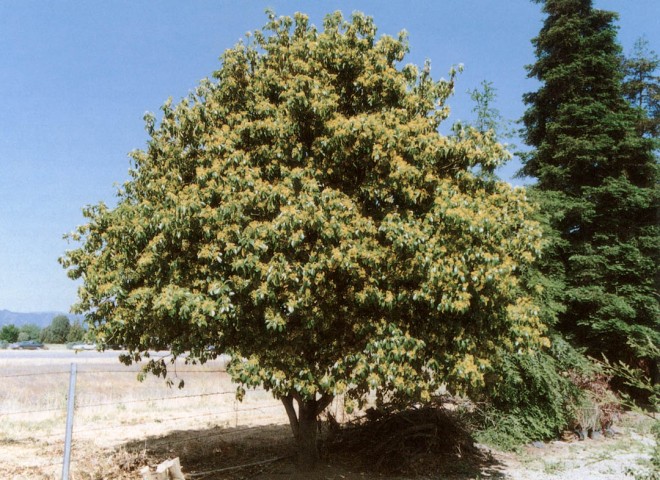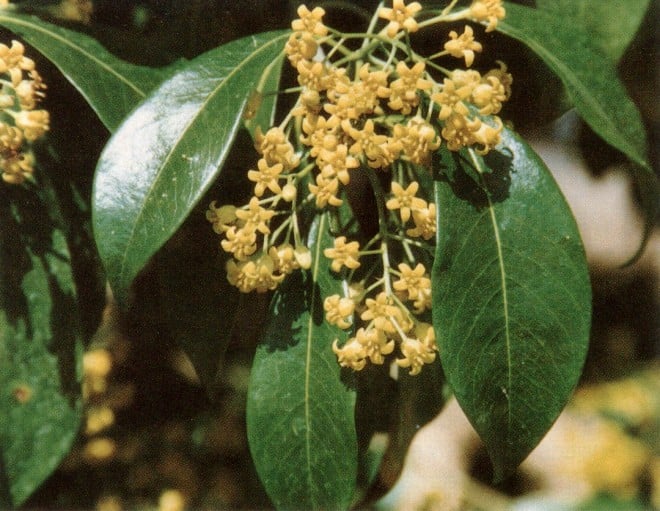
A New Pittosporum

Contributor
- Topics: Plants You Need

The Saratoga Horticultural Research Foundation has, as part of its mission to find and introduce into the green industry trees which are suitable for landscaping small areas: attractive, compact trees that will not disrupt sidewalks, foundations, and other concrete work. In Pittosporum brevicalyx, the Foundation appears to have found a candidate that meets the needs of homeowners seeking an attractive, moderately small tree.
Native to China, Pittosporum brevicalyx first came to the attention of the Saratoga Horticultural Research Foundation (SHRF) in the early 1980s. In 1980, Stephen Spongberg of the Arnold Arboretum near Boston, traveling with other botanists in the first Sino-American Botanical Expedition to the People’s Republic of China, collected seeds from P. brevicalyx outside the Golden Temple near Kunming in Yunnan Province, China. From the seeds collected, nine survived as seedlings and were potted up. Phillip McMillan Browse, director of SHRF at the time, received one of the seedlings in 1982. The seedling was grown on and planted in the rear of the foundation’s property in 1986. As early as 1989, research director Joe Solomone recognized the potential of this new tree.
SHRF is located in the middle of the Santa Clara Valley, some thirty-five miles south of San Jose. The soil in the area is heavy clay with a pH of 8.2 (highly alkaline) and a boron content above normal. Rainfall in the area averages fourteen inches per year, falling almost entirely between October and April. Temperatures in the area generally range between 95˚F in the summer and 30˚F in the winter, with a mean summer temperature of 68.9˚F and a mean winter temperature of 50.4˚F. During the winter of 1990-91, temperatures in the area dropped to 18˚F. Pittosporum brevicalyx has thrived in full sun at its present location since 1986. (To the best of our knowledge, none of the other nine seedlings survived, presumably because of the much lower temperatures in Massachusetts.)

Our tree has now reached a height of eighteen feet with a crown sixteen feet in diameter. It has a single trunk at one foot above the ground, and at four feet has seven strong scaffold branches. Had the tree produced a single trunk to a height of four or five feet above ground, it is estimated that it would be thirty percent taller with a somewhat smaller crown. The oblanceolate leaves on this evergreen tree are four to five inches long and one and one-half to two inches wide, with entire margins; petioles are one-half to three-quarters of an inch long. The leaf is leathery with a smooth, glossy, dark green upper surface and a slightly silvery-green lower surface. During mid-spring (late April to early June), the tree is covered with goldenrod-yellow, umbel-like clusters of three-eighths-inch flowers whose petals are strongly reflexed; each cluster may hold from seventy to one hundred or more individual blossoms. The blossoms have a delicate and pleasant fragrance, likened by some to lilac, and by others to magnolia or jasmine, but not as strong.
Propagated from the Foundation’s original tree is a smaller plant growing on the campus of Stanford University. It is performing well in spite of competition from a number of larger trees shading it. It is about one-half the size of the mother plant and five years younger.
Pittosporum brevicalyx produces very few seed pods at Saratoga, unlike its cousin, Victorian box (P. undulatum). The few capsules produced are round, firm and one-half inch in diameter, without the sticky residue associated with most species of Pittosporum. At SHRF most of the capsules produced are on the south and west sides of the tree.
[sidebar]
The Saratoga Horticultural Research Foundation is a non-profit organization dedicated to the introduction of new plants appropriate to the California climate. The work of the Foundation is supported by individual and corporate memberships and by grants from water departments and other government agencies.
The Foundation is located at 15185 Murphy Avenue, San Martin, CA 95046. Plants propagated by the Foundation are available at spring and fall festivals and at monthly sales. Membership information can be obtained by calling 480/779-3303.
[/sidebar]
The original specimen at SHRF does not attract aphids nor has it shown any symptoms of disease. A small amount of leaf-tip burn has been noticed but this is attributed to the high boron content of the soil. Since becoming established, the tree has received no supplementary irrigation.
Pittosporum brevicalyx propagates easily from cuttings; shoot growth reaches six to twelve inches by the end of June. Currently it is being propagated in quantity at SHRF, under the cultivar name of ‘Golden Temple’ and will soon be available on a limited commercial basis.
In this cultivar, we appear to have a moderately small, evergreen tree with fragrant yellow blossoms, a non-invasive root system, disease and insect resistance, and little or no undesirable fruit production—characteristics that suggest its use as a street or in the home garden.
Share:
Social Media
Garden Futurist Podcast
Most Popular
Videos
Topics
Related Posts

Ground Up Science for Greener Cities with Garden Futurist Dr. Alessandro Ossola
Spring 2023 Listen to the Podcast here. Alessandro Ossola is a scientist who gets very excited about the challenge of climate change allowing for an

Readying Urban Forests for Climate Realities with Garden Futurist Dr. Greg McPherson
Winter 2023 Listen to the Podcast here. “Going from the mow and blow to a more horticulturally knowledgeable approach to maintaining the landscape. And that

Welcome, Greywater, to the Garden
Summer 2022 Oh, summer: delightful warm air, tomatoes swelling on the vine, fragrant blooms on an evening stroll. When it’s warm and rainless, how is

Big Tree-Data and Big-Tree Data with Garden Futurist Matt Ritter
Summer 2022 Listen to the full Garden Futurist: Episode XV podcast here. We are in an environmental crisis right now in many parts of California










Responses